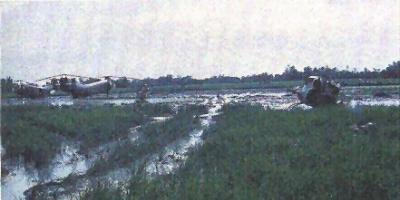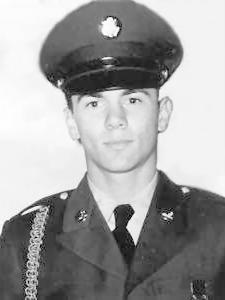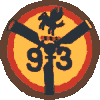A Note from The Virtual Wall
The 02 Jan 1963 fight at Ap Bac, a hamlet located in Kien Tuong Province southwest of Saigon, was a catastrophe from start to finish:
- Although the ARVN expected to face a VC company of 120 or so men, there was in fact a VC battalion there.
- Although tactical surprise was expected, the VC had gotten wind of the attack and were well prepared for it.
- Although the ARVN intended a multi-pronged attack by armor and infantry, with air support, deficiencies in the command structure prevented integration of forces.
- Finally, although the VC were entrenched in a north-south tree line running from the hamlet of Tan Thoi through Ap Bac, all the ARVN forces were bought to bear from the south and west, thereby allowing the VC a clear path for withdrawal to the east.
The ARVN were supported by American advisors and American helicopter support - the latter from the 145th Aviation Battalion's UTT Company (UH-1) and 93rd Transportation Company (CH-21). Five UH-1s acted as gunships, while the 93rd's ten CH-21s provided airlift. The MAAGV advisors could only advise - they could not command. Although the senior advisor, LTC John P. Vann, argued against the employment of forces, the ARVN commanders chose not to follow his advice. It is difficult in retrospect to second-guess either American advisors or ARVN commanders, but the fight can only be described as a VC win. Despite being grossly outnumbered and outgunned, the VC traded 18 known dead for 60+ ARVN dead and 3 Americans - and withdrew safely to the east when their position became untenable.
The Americans killed at Ap Bac were
- CPT Kenneth N. Good, San Marino, CA, US Army Element, MAAGV (Silver Star)
- SGT William L. Deal, Mays Landing, NJ, UTT Hel Co, 145th Avn Bn
- SP4 Donald L. Braman, Mystic, CT, 93rd Trans Co, 145th Avn Bn (Dist Flying Cross)
THE BATTLE OF AP BAC
"The battle of Ap Bac, sixty-five kilometers southwest of Saigon in the Mekong Delta in January 1963, illustrates the early problems faced by the developing armored forces of the ARVN . The month before, Vietnamese Army intelligence had reported a reinforced Viet Cong company in Ap Tan Thoi, 1,500 meters northwest of Ap Bac. (Map) The Vietnamese 7th Division planned an operation to trap the Viet Cong by landing the 11th Infantry Regiment to the north by helicopter while a provisional regiment of two battalion-size task forces of Civil Guards (later named Regional Forces) moved in from the south. The 4th Mechanized Rifle Squadron, 2d Armored Cavalry, commanded by Captain Ba, was attached to the provisional regiment and was to attack from the southwest. Three Vietnamese Ranger and infantry companies were in reserve, with artillery and air support on call.
"In contrast to the intelligence estimate, the enemy force actually consisted of three main force companies, reinforced with machine guns, 60-mm. mortars, and several local guerrilla units. The Viet Cong after action report subsequently captured revealed that the enemy knew a battle was imminent and had carefully prepared defensive positions along the Cong Luong Canal from Ap Tan Thoi to Ap Bac. The canal, bordered with vegetation, offered concealment and unobstructed fields of fire across the open rice paddies.
"On the morning of 2 January 1963 the Civil Guard task forces started north, while in three uneventful trips helicopters lifted the Vietnamese 11th Infantry Regiment into position. About 0730 Task Force A encountered the southern flank of the Viet Cong positions along the Cong Luong Canal. During the first moments of battle, the task force commander was wounded and a company commander killed. Major Lam Quang Tho, commander of the 2d Armored Cavalry Regiment and also province chief, refused to allow the provincial forces to advance, and changed their mission to one of occupying blocking positions. Colonel Bui Dinh Dam, 7th Division commander, decided to commit a reserve force to the west side of the canal that runs through Ap Bac. At 1020 as the helicopters came in for their fourth lift, the Viet Cong antiaircraft crews hidden along the canal opened fire. Of the 15 helicopters bringing in the reserve, 14 were hit, and by noon 5 had been shot down."
From
"Armored Combat in Vietnam", General D. A. Starry, Blandford Books Ltd., 1981
Reproduced under 17 USC ï¿ 1/2 107

Ap Bac
Downed CH-21 helos (left) and UH-1B (right) in a rice paddy west of the hamlet
|
On 02 Jan 1963, the 93rd Transportation Company was tasked for an air assault by troops of the ARVN 7th Infantry Division. All ten CH-21 helicopters were used in the lift. On the fourth lift, the landing zone (near Ap Bac) was ambushed by an entrenched and reinforced VC battalion. Although the first four CH-21s were hit by ground fire, they were able to take off again. The #5 helicopter was shot down. The #6 CH-21 unhesitatingly diverted its take-off and attempted to pick up the crew of the downed CH-21 but was itself shot down.
The landing zone was judged untenable due to enemy fire, preventing further rescue attempts, and the remainder of the flight departed for the staging area at Tan Hiep. The #2 CH-21 made a forced landing enroute due to damage, and its crew found themselves under enemy fire for the next eight hours.
At the staging area, only two of the remaining seven remaining helicopters were flyable. Approximately one hour later information was received from ground troops in the area that the VC firing had subsided and evacuation of the downed crews was possible. A CH-21 was dispatched and landed despite sporadic ground fire. While attempting to load the downed crews and wounded, the tempo of enemy fire increased and the pilot was wounded. The copilot immediately lifted off, leaving the wounded and crews behind, but had to make a forced landing about 1/2 mile away.
At Tan Hiep, two other helicopters had been repaired by cannibalizing other aircraft. The three flyable aircraft spent the rest of the afternoon in ammunition resupply and medivac missions into the first three landing zones.
Approximately eight hours after being shot down, the downed aircrews were picked up by ARVN armored personnel carriers and moved to an area where they could be evacuated by helicopter.
At day's end, nine [93rd TC soldiers] had been wounded and one killed in action. Of the ten helicopters committed on the mission, all ten had been hit by enemy fire, four had been shot down, and only three could be flown back to base.
SP4 Braman, gunner in the #6 CH-21, was the dead American. He received a posthumous Distinguished Flying Cross for his actions during the attempt to recover the downed #5 aircrew. Fort Rucker's Braman Hall (classroom Building 6022) is named in his honor.
The 93rd Transportation Company was redesignated the 121st Aviation Company (June 1963) and eventually became the 121st Assault Helicopter Company.
From the
Army Transportation School Museum
|
Vietnamese Ignored U.S. Battle Order
Saigon, Jan. 6 (UPI) Angry United States military advisers charged today that Vietnamese infantrymen refused direct orders to advance during Wednesday's battle at Ap Bac and that an American Army captain was killed while out front pleading with them to attack. The Vietnamese commander of an armored unit also refused for more than an hour to go to the rescue of 11 American crewmen of downed helicopters and an infantry company pinned down by Communist small arms fire, they said.
"It was a miserable damn performance" was the way one American military man summed up the humiliating and costly defeat suffered by the South Vietnamese army at the hands of outnumbered Communist guerrillas in the fight for the jungle hamlet 30 miles south of Saigon.
It was perhaps the strongest criticism by an American military adviser, but others in the battle said it was not an unfair one.
They spoke of the marked "lack of aggressiveness" of Vietnamese commanders, their refusal to heed recommendations of their American advisers, refusal to carry out orders from their superiors and a breakdown in the chain of command of the 7th Vietnamese Division.
As a result, the American sources said, the government troops suffered a needlessly high casualty toll, 65 dead and at least 100 wounded, the second highest since the war against the Communist Viet Cong began.
American advisers who took part in the battle on the edge of the Plain of Reeds recounted sorry tales of the debacle: Government forces out numbered the Communists by 10 to 1 and were supported by planes, artillery and armor.
Yet an infantry battalion located less than a mile from Ap Bac flatly refused to advance on the hamlet even though Vietnamese and American officers at division headquarters ordered and pleaded for hours. About 200 guerrillas held Ap Bac.
The battalion commander had been killed and the other officers refused to assume command. Capt. Good was killed while out in front trying to get the Vietnamese to attack.
A Vietnamese captain commanding an armored-personnel carrier company refused for 70 minutes to cross a canal to rescue downed U.S. helicopter crewmen and a company of Vietnamese infantry pinned down by small arms fire.
The captain kept complaining about "heavy enemy fire," even though U.S. advisers urged him to advance because the small arms fire could not penetrate the armored vehicles. He finally gave in to radioed orders and pleading from U.S. and Vietnamese officers and rescued most of the Vietnamese and American wounded.
Then the captain attacked twice but retreated after Communist fire kept picking off exposed machine gunners on the armored cars. U.S. advisers said the captain should have "buttoned up" the armored vehicles and run over the Viet Cong forward positions as he had been trained to do.
Most of the Communists were able to withdraw from the hamlet during the night because a paratroop battalion was dropped on the west side of the hamlet instead of the east, leaving an escape route into the jungles.
An American general narrowly escaped being killed when Vietnamese artillery accidentally shelled their own troops after the fight was over.
The advisers said American patience came to an end Friday when a civil guards company failed to move into a blocking position as ordered, leaving a U.S. Army major alone in a paddy field to face guerrilla stragglers.
Lt. Col. John Paul Vann, senior U.S. adviser with the 7th Vietnamese Division, quickly rounded up 60 American advisers, cooks and communications men from his headquarters and sent them to the aid of the major.
The Americans were under strict orders not to fire unless fired upon. They rescued the major and captured 17 guerrillas without suffering any casualties and then returned to their regular duties.
One U.S. adviser said bitterly, "These people (the Vietnamese) won't listenï¿ 1/2 they make the same mistakes over and over again in the same way."
From the
The Washington Post, January 7, 1963
Reproduced under 17 USC ï¿ 1/2 107
|
|








